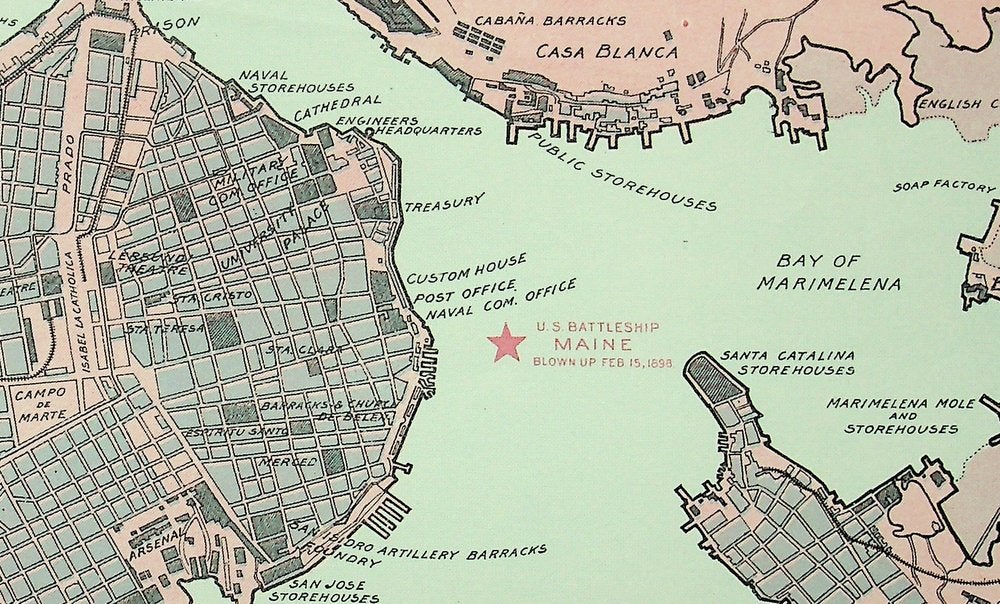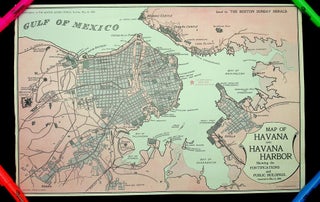Map of Havana and Havana Harbor Showing the FORTIFICATIONS and PUBLIC BUILDINGS Corrected to May 3, 1898
[ Boston, Massachusetts ]: Boston Sunday Herald 1898. First Edition. Single sheet 9 7/8 x 15 inches. Lithographed by G. H. Buek & Co. N.Y. Issued as a supplement to the Boston Sunday Herald, Sunday, May 22, 1898. Some creasing but no tearing. The map retains its white margins (this map is often trimmed to the double black border) and is in as-issued form. Very Good. [28820]
We offer a map of Havana and Havana Harbor extending from Morro Castle/El Morro Light and the Gulf of Mexico at the top to Belot Cemetary upper right, Regla and the Bay of Guasabacoa lower right, Cerro lower left, and Sta Clara Battery upper left. The map identifies military installations, towns, some streets, and other key features such as Campo de Marte, Cavalry Barracks, Plaza de Toros, Sta. Cristo, Regla Fruit Storehouses, Soap Factory, University Palace, Antares Castle, English Cemetary, Western R. R., Guanabacoa and Matanzas R. R., Principe Castle, San Nazario Battery, etc., etc.
In the center of the map just to the right of the Naval Com. Office in the Bay of Marimelena is a red printed star labeled "U.S. BATTLESHIP MAINE BLOWN UP FEB 15, 1898" The phrase "Remember the Maine" came from this event. 100 years afterward, Smithsonian writer Tim Miller (Smithsonian Magazine, Feb 1998) summarized the event and how the Maine is still in our collective memories:
"On February 15, 1898, a mysterious explosion destroyed the American battleship Maine in Havana Harbor and helped propel the United States into a war with Spain. The USS Maine was in Cuba, officially, on a mission of friendly courtesy and, incidentally, to protect American lives and property in the event that Cuba's struggle for independence from Spain might escalate into full-blown warfare. "Yet," writes author Tom Miller, "the visit was neither spontaneous nor altruistic; the United States had been eyeing Cuba for almost a century."
On board the Maine that sultry Tuesday night were 350 crew and officers. Shortly after 9 p.m. the ship's bugler, C. H. Newton, blew taps. The ship bobbed listlessly, its imposing 100-yard length visible from stem to stern. "At 9:40 p.m.," writes Miller, "the ship's forward end abruptly lifted itself from the water. Along the pier, passersby could hear a rumbling explosion. Within seconds, another eruption--this one deafening and massive--splintered the bow, sending anything that wasn't battened down, and most that was, flying more than 200 feet into the air.... In all, 266 of the 350 men aboard the Maine were killed." The American press was quick to point to an external explosion--a mine or torpedo--as the cause of the tragedy. An official U.S. investigation agreed. On April 25, 1898, Congress formally declared war on Spain. By summer's end, Spain had ceded Cuba, along with the Philippines, Puerto Rico and Guam, to the United States.
In 1976, Adm. Hyman Rickover of the U.S. Navy mounted yet another investigation into the cause of the Maine disaster. His team of experts found that the ship's demise was self-inflicted--likely the result of a coal bunker fire. There are those, however, who still maintain that an external blast was to blame. Some people, it seems, just won't let you forget the Maine."
ITEM SOLD




